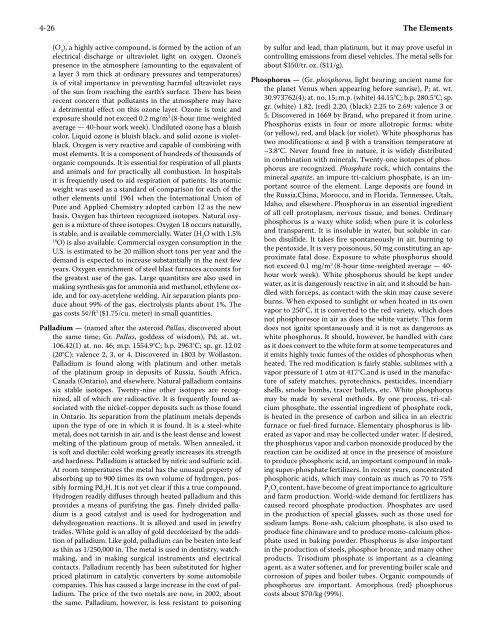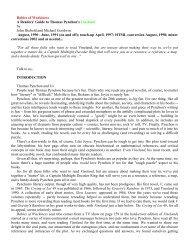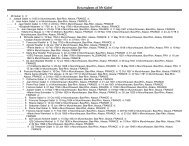CRC Handbook of Chemistry and Physics, 86th Edition
CRC Handbook of Chemistry and Physics, 86th Edition
CRC Handbook of Chemistry and Physics, 86th Edition
Create successful ePaper yourself
Turn your PDF publications into a flip-book with our unique Google optimized e-Paper software.
4-26 The Elements<br />
(O 3 ), a highly active compound, is formed by the action <strong>of</strong> an<br />
electrical discharge or ultraviolet light on oxygen. Ozone’s<br />
presence in the atmosphere (amounting to the equivalent <strong>of</strong><br />
a layer 3 mm thick at ordinary pressures <strong>and</strong> temperatures)<br />
is <strong>of</strong> vital importance in preventing harmful ultraviolet rays<br />
<strong>of</strong> the sun from reaching the earth’s surface. There has been<br />
recent concern that pollutants in the atmosphere may have<br />
a detrimental effect on this ozone layer. Ozone is toxic <strong>and</strong><br />
exposure should not exceed 0.2 mg/m 3 (8-hour time-weighted<br />
average — 40-hour work week). Undiluted ozone has a bluish<br />
color. Liquid ozone is bluish black, <strong>and</strong> solid ozone is violetblack.<br />
Oxygen is very reactive <strong>and</strong> capable <strong>of</strong> combining with<br />
most elements. It is a component <strong>of</strong> hundreds <strong>of</strong> thous<strong>and</strong>s <strong>of</strong><br />
organic compounds. It is essential for respiration <strong>of</strong> all plants<br />
<strong>and</strong> animals <strong>and</strong> for practically all combustion. In hospitals<br />
it is frequently used to aid respiration <strong>of</strong> patients. Its atomic<br />
weight was used as a st<strong>and</strong>ard <strong>of</strong> comparison for each <strong>of</strong> the<br />
other elements until 1961 when the International Union <strong>of</strong><br />
Pure <strong>and</strong> Applied <strong>Chemistry</strong> adopted carbon 12 as the new<br />
basis. Oxygen has thirteen recognized isotopes. Natural oxygen<br />
is a mixture <strong>of</strong> three isotopes. Oxygen 18 occurs naturally,<br />
is stable, <strong>and</strong> is available commercially. Water (H 2 O with 1.5%<br />
18 O) is also available. Commercial oxygen consumption in the<br />
U.S. is estimated to be 20 million short tons per year <strong>and</strong> the<br />
dem<strong>and</strong> is expected to increase substantially in the next few<br />
years. Oxygen enrichment <strong>of</strong> steel blast furnaces accounts for<br />
the greatest use <strong>of</strong> the gas. Large quantities are also used in<br />
making synthesis gas for ammonia <strong>and</strong> methanol, ethylene oxide,<br />
<strong>and</strong> for oxy-acetylene welding. Air separation plants produce<br />
about 99% <strong>of</strong> the gas, electrolysis plants about 1%. The<br />
gas costs 5¢/ft 3 ($1.75/cu. meter) in small quantities.<br />
Palladium — (named after the asteroid Pallas, discovered about<br />
the same time; Gr. Pallas, goddess <strong>of</strong> wisdom), Pd; at. wt.<br />
106.42(1) at. no. 46; m.p. 1554.9°C; b.p. 2963°C; sp. gr. 12.02<br />
(20°C); valence 2, 3, or 4. Discovered in 1803 by Wollaston.<br />
Palladium is found along with platinum <strong>and</strong> other metals<br />
<strong>of</strong> the platinum group in deposits <strong>of</strong> Russia, South Africa,<br />
Canada (Ontario), <strong>and</strong> elsewhere. Natural palladium contains<br />
six stable isotopes. Twenty-nine other isotopes are recognized,<br />
all <strong>of</strong> which are radioactive. It is frequently found associated<br />
with the nickel-copper deposits such as those found<br />
in Ontario. Its separation from the platinum metals depends<br />
upon the type <strong>of</strong> ore in which it is found. It is a steel-white<br />
metal, does not tarnish in air, <strong>and</strong> is the least dense <strong>and</strong> lowest<br />
melting <strong>of</strong> the platinum group <strong>of</strong> metals. When annealed, it<br />
is s<strong>of</strong>t <strong>and</strong> ductile; cold working greatly increases its strength<br />
<strong>and</strong> hardness. Palladium is attacked by nitric <strong>and</strong> sulfuric acid.<br />
At room temperatures the metal has the unusual property <strong>of</strong><br />
absorbing up to 900 times its own volume <strong>of</strong> hydrogen, possibly<br />
forming Pd 2 H. It is not yet clear if this a true compound.<br />
Hydrogen readily diffuses through heated palladium <strong>and</strong> this<br />
provides a means <strong>of</strong> purifying the gas. Finely divided palladium<br />
is a good catalyst <strong>and</strong> is used for hydrogenation <strong>and</strong><br />
dehydrogenation reactions. It is alloyed <strong>and</strong> used in jewelry<br />
trades. White gold is an alloy <strong>of</strong> gold decolorized by the addition<br />
<strong>of</strong> palladium. Like gold, palladium can be beaten into leaf<br />
as thin as 1/250,000 in. The metal is used in dentistry, watchmaking,<br />
<strong>and</strong> in making surgical instruments <strong>and</strong> electrical<br />
contacts. Palladium recently has been substituted for higher<br />
priced platinum in catalytic converters by some automobile<br />
companies. This has caused a large increase in the cost <strong>of</strong> palladium.<br />
The price <strong>of</strong> the two metals are now, in 2002, about<br />
the same. Palladium, however, is less resistant to poisoning<br />
by sulfur <strong>and</strong> lead, than platinum, but it may prove useful in<br />
controlling emissions from diesel vehicles. The metal sells for<br />
about $350/tr. oz. ($11/g).<br />
Phosphorus — (Gr. phosphoros, light bearing; ancient name for<br />
the planet Venus when appearing before sunrise), P; at. wt.<br />
30.973762(4); at. no. 15; m.p. (white) 44.15°C; b.p. 280.5°C; sp.<br />
gr. (white) 1.82, (red) 2.20, (black) 2.25 to 2.69; valence 3 or<br />
5. Discovered in 1669 by Br<strong>and</strong>, who prepared it from urine.<br />
Phosphorus exists in four or more allotropic forms: white<br />
(or yellow), red, <strong>and</strong> black (or violet). White phosphorus has<br />
two modifications: α <strong>and</strong> β with a transition temperature at<br />
–3.8°C. Never found free in nature, it is widely distributed<br />
in combination with minerals. Twenty-one isotopes <strong>of</strong> phosphorus<br />
are recognized. Phosphate rock, which contains the<br />
mineral apatite, an impure tri-calcium phosphate, is an important<br />
source <strong>of</strong> the element. Large deposits are found in<br />
the Russia,China, Morocco, <strong>and</strong> in Florida, Tennessee, Utah,<br />
Idaho, <strong>and</strong> elsewhere. Phosphorus in an essential ingredient<br />
<strong>of</strong> all cell protoplasm, nervous tissue, <strong>and</strong> bones. Ordinary<br />
phosphorus is a waxy white solid; when pure it is colorless<br />
<strong>and</strong> transparent. It is insoluble in water, but soluble in carbon<br />
disulfide. It takes fire spontaneously in air, burning to<br />
the pentoxide. It is very poisonous, 50 mg constituting an approximate<br />
fatal dose. Exposure to white phosphorus should<br />
not exceed 0.1 mg/m 3 (8-hour time-weighted average — 40hour<br />
work week). White phosphorus should be kept under<br />
water, as it is dangerously reactive in air, <strong>and</strong> it should be h<strong>and</strong>led<br />
with forceps, as contact with the skin may cause severe<br />
burns. When exposed to sunlight or when heated in its own<br />
vapor to 250°C, it is converted to the red variety, which does<br />
not phosphoresce in air as does the white variety. This form<br />
does not ignite spontaneously <strong>and</strong> it is not as dangerous as<br />
white phosphorus. It should, however, be h<strong>and</strong>led with care<br />
as it does convert to the white form at some temperatures <strong>and</strong><br />
it emits highly toxic fumes <strong>of</strong> the oxides <strong>of</strong> phosphorus when<br />
heated. The red modification is fairly stable, sublimes with a<br />
vapor pressure <strong>of</strong> 1 atm at 417°C,<strong>and</strong> is used in the manufacture<br />
<strong>of</strong> safety matches, pyrotechnics, pesticides, incendiary<br />
shells, smoke bombs, tracer bullets, etc. White phosphorus<br />
may be made by several methods. By one process, tri-calcium<br />
phosphate, the essential ingredient <strong>of</strong> phosphate rock,<br />
is heated in the presence <strong>of</strong> carbon <strong>and</strong> silica in an electric<br />
furnace or fuel-fired furnace. Elementary phosphorus is liberated<br />
as vapor <strong>and</strong> may be collected under water. If desired,<br />
the phosphorus vapor <strong>and</strong> carbon monoxide produced by the<br />
reaction can be oxidized at once in the presence <strong>of</strong> moisture<br />
to produce phosphoric acid, an important compound in making<br />
super-phosphate fertilizers. In recent years, concentrated<br />
phosphoric acids, which may contain as much as 70 to 75%<br />
P 2 O 5 content, have become <strong>of</strong> great importance to agriculture<br />
<strong>and</strong> farm production. World-wide dem<strong>and</strong> for fertilizers has<br />
caused record phosphate production. Phosphates are used<br />
in the production <strong>of</strong> special glasses, such as those used for<br />
sodium lamps. Bone-ash, calcium phosphate, is also used to<br />
produce fine chinaware <strong>and</strong> to produce mono-calcium phosphate<br />
used in baking powder. Phosphorus is also important<br />
in the production <strong>of</strong> steels, phosphor bronze, <strong>and</strong> many other<br />
products. Trisodium phosphate is important as a cleaning<br />
agent, as a water s<strong>of</strong>tener, <strong>and</strong> for preventing boiler scale <strong>and</strong><br />
corrosion <strong>of</strong> pipes <strong>and</strong> boiler tubes. Organic compounds <strong>of</strong><br />
phosphorus are important. Amorphous (red) phosphorus<br />
costs about $70/kg (99%).







